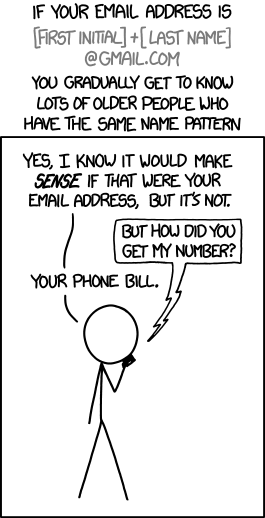I’m working on a blog post about the new Gmail tabbed inbox and the messages Gmail is inserting into the promotions tab. The messages aren’t showing up on most of my accounts, so I logged into an infrequently used account of mine. Ads are there, I got my screenshots and some data about the behaviour of the messages. So far so good.
I also discovered that at least two other women are using my address. One of them apparently ordered a bunch of wedding stuff from David’s Bridal shop using my email address. I hope Kirstie got her special order in time.
The other case is more interesting. I found dozens of emails in my inbox from what appeared to be friends including me in their email forward chain.
The Comic Sans. The FW:FW:FW:FW:FW subject lines. The horribly drawn cartoons. The inspirational messages. The prayer requests. The invites to bridge night. The followup demands that I reply to their invites for bridge night. The sad emails that I didn’t go to bridge night. There were emails from grandchildren. Questions about where I’d been and if I moved. Prayer chains. The messages go on and on.
Looking back through my inbox, this has been going on since sometime late in 2012. (Told you this was an infrequently used account). I looked and looked and I think I figured out what happened. A woman named Helen appears to to have an email address one letter off from mine (string@ vs stringsstring@) and one of her church friends tried to reply to her and dropped the ‘s’ from the email address. Once she did that, everyone else just kept hitting “reply all” and are including me in their forward chain.
It’s not commercial, it’s not spam. It’s just a bunch of people mistyping an email address and sending mail to someone they don’t know. I’m kinda glad it was a bunch of church ladies rather than Carlos Danger sending … well… Carlos Danger type messages.
People get email addresses wrong sometimes. It happens (ask me about the time I almost got my mailserver blocked because I mistyped an address while sending mail to a blocklist maintainer and hit a trap address by mistake…). The problem is that it can overwhelm an uninvolved person’s mailbox, even when it’s not commercial. Sure, if I was logging in to this account more often I’d probably have shut it down, but if they were paying attention they would have realized Helen is never replying to anything they send.
I kinda feel the same about commercial mailers that send me mail over and over and over again. I never open it, I never reply to it, I never respond to it. I wonder if there is actually anyone actually sending the mail, or if there’s just a lonely mailserver bricked up in a wall somewhere continually sending out spam.
Don’t be the bricked up server in the wall. Pay attention to what your recipients are doing.
Read More